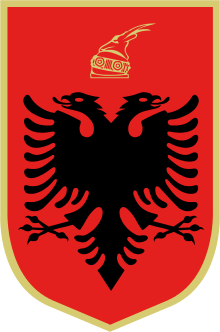Albanian mythology
| Part of a series on |
| Albanians |
|---|
 |
| States |
| Communities |
| Subgroups |
| People |
Albanian mythology comprises myths and legends of the Albanians. Many of the characters in Albanian mythology are included in the Albanian Songs of the Frontier Warriors (Albanian: Këngë Kreshnikësh or Cikli i Kreshnikëve), the traditional cycle of Albanian epic songs.
History
The elements of Albanian mythology are of Paleo-Balkanic origin and almost all of them are pagan.[1] Albanian myths can be divided into two major groups: legends of metamorphosis and historical legends.
Albanian folk tales were first recorded in the middle of the nineteenth century by European scholars such as Johann Georg von Hahn, the Austrian consul in Janina (Ioannina), Karl H. Reinhold and Giuseppe Pitrè. The next generation of scholars to take an interest in the collection of Albanian folk tales were primarily philologists, among them well-known Indo-European linguists concerned with recording and analysing a hitherto little known European language: Auguste Dozon, Jan Jarnik, Gustav Meyer, Holger Pedersen, Gustav Weigand and August Leskien.
The nationalist movement in Albania in the second half of the nineteenth century, the so-called Rilindja period, gave rise to native collections of folklore material such as the 'Albanian Bee' (Albanike melissa / Belietta sskiypetare) by Thimi Mitko, the 'Albanian Spelling Book' (Albanikon alfavetarion / Avabatar arbëror) by the Greco-Albanian Anastas Kullurioti and the 'Waves of the Sea' (Valët e Detit) by Spiro Dine. In the last thirty years, much field work has been done by the Institute of Folk Culture in Tirana and by the Institute of Albanian Studies in Prishtina, which have published numerous collections of folk tales and legends. Unfortunately, very little of this substantial material has been translated into other languages.
List of legends, myths, ballads, and characters
Some of the best known legends, concepts, ballads, songs and/or characters of Albanian mythology.
- [[]]
- Afërdita
- Armati
- Bardha
- Bindusi
- Baloz (monster)
- Constantin and Doruntinë
- Dhampir
- Demeter / (Dhemeter)
- Djall (devil)
- Dreq (demon)
- Drangue
- E bija e Henës dhe e Diellit
- E Bukura e Dheut
- E Bukura e Detit
- E Bukura e Qiellit
- Eia
- En (Illyrian god)
- Fatit
- Gjergj Elez Alia
- Gjysmagjeli
- Gogol (monster)
- Hajnjeri
- Iria
- Judi
- Jola
- Kacamisri (similar to Tom Thumb)
- Katallan (giant)
- Katravesh
- Karkanxholl (werewolf)
- Keshete (naiad)
- Kreshniku
- Kukudhi
- Kuçedra
- Latra
- Lugat (vampire)
- Ljubi
- Mauthia
- Muji edhe Halili
- Merkur
- Nuse mali (Nymph of the Mountain)
- Ora (mythological creature)
- Perëndi
- Perit
- Prende
- Premte
- Princess Argjiro
- Rodon
- Rozafati
- Shtojzovalle (sylph)
- Shtriga
- Shurdhi
- Shejntona / Sentona
- Stihi
- The Tale of the Eagle
- Tadeni
- Tomor
- Thopc (gnome)
- Verbti
- Ymer Agë Ulqini
- Xhindi
- Zana e malit (Mountain Fairy)
- Zojzi
- -=(ウAlevZotiXXウ)=-
See also
References
- ↑ Bonefoy, Yves (1993). American, African, and Old European mythologies. University of Chicago Press. p. 253. ISBN 0-226-06457-3.
Further reading
- Robert Elsie (1994). Albanian Folktales and Legends. Naim Frasheri.
- Martin Mato "New View on old Text" in newspaper Albanian Daily News, f 10 30 Nov. 1996, Tiranë
